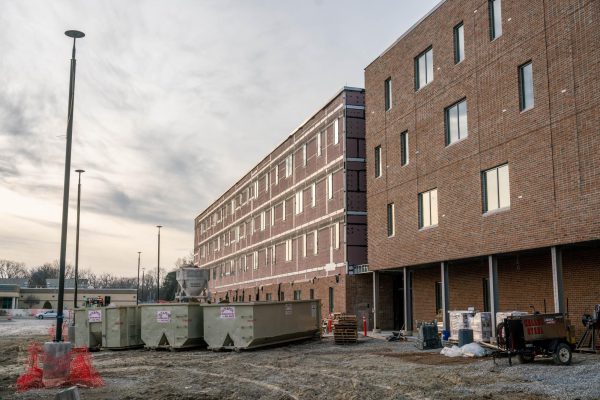Jaywalking Tickets Upset Students
Recent jaywalking tickets issued by the Oberlin Police Department have launched a campus-wide conversation about pedestrian safety on campus. Last week, the Oberlin Police Department barricaded the informal crosswalk on West Lorain Street connecting the Science Center to Wilder Bowl and issued three citations to students crossing there instead of down the street at the formal crosswalk.
“This area was chosen to be shut down for several reasons; we’ve received several complaints, it’s a highly jaywalked area, traffic moves at the 35mph speed limit here, and there is a REAL painted crosswalk about 100 feet down the road that should be used,” read a statement posted on the Oberlin Police Department’s Facebook page.
College fourth-year Buster Coe was one of the students who received a citation and was upset by the experience.
“It was kind of annoying, you know, it was 111 bucks for jaywalking,” Coe said. “[The officer] could have just given me a written warning.”
Chief of Police Ryan Warfield says that the police department receives complaints every year about students using the informal crosswalk, particularly at the start of the academic year. Even though West Lorain Street goes directly through Oberlin, many students don’t know that it is part of State Route 511.
“The state does control where the crosswalks are located, and it has to be at the intersection of Woodland [and West Lorain Street],” said Director of Campus Safety Mike Martinsen.
In 2012, there was an effort by the city to explore lowering the speed limit on this stretch of West Lorain Street from 35 to 25 mph.
“[There is a] perception that people always drive too fast through there,” explained City of Oberlin Director of Public Works Jeff Bauman.
However, a traffic study found that most drivers actually travel below the 35 mph speed limit. Following the study, the City of Oberlin did not try to obtain approval from the Ohio Transportation District office to change the speed limit.
As for Campus Safety’s response to the recent citations, Martinsen is trying to encourage students to cross in a safer — and legal — way.
“We’re taking a two-pronged approach,” Martinsen said. “One [factor] is structural enhancement [that will be combined with] strategies we can implement to channel behavior in a positive, safer direction.”
Bauman says that, when the Science Center was built, there were structural efforts made to discourage crossing.
“The architects referred to those sandstone columns [outside of the West Lorain Street entrance of the Science Center] as physiographic barriers,” he said.
However, these columns have proven ineffective. Martinsen hopes that he can implement new solutions to reroute the flow of traffic, such as changing sidewalks or adding hedges.
“[These are] structure-type improvements that are going to involve redirecting the flow [of pedestrians] … to the legal crossing areas,” Martinsen said.
Martinsen is currently working alongside Vice President and Dean of Students Meredith Raimondo, Oberlin City Manager Rob Hillard, and Oberlin Chief of Police Ryan Warfield to find a solution. Martinsen also emphasized education, especially for international students and students from states where rules might be different.
“I’m from New York City, where we jaywalk all the time,” Coe says. “It didn’t even register to me that I was going to get a ticket for jaywalking. I didn’t even know that was in the realm of possibility.”
College second-year David Mathisson echoes this sentiment.
“When everybody was getting ticketed for jaywalking, there was a lot of frustration, anger, and energy in the community around that,” Mathisson said.
In response, Mathisson organized a Collective Jaywalking event on Facebook in hopes that students could all gather and illegally cross the street at the same time as a form of protest. He called it off on Tuesday after conversations with College administrators — conversations that he hopes to continue into the future.
“[This] will involve a group of students led by me to work directly with the administration,” Mathisson said. “After the preliminary planning stages, [we] will link up with the City of Oberlin and police department as well for a solution that involves every single part of the Oberlin community.”
Mathhisson also stated a hope to reach an agreement with faculty to excuse student tardiness due to use of the official crosswalk.
Some students have expressed dissatisfaction with student activism focused on resolving the jaywalking issue.
“The whole thing came off as very entitled to me,” said College fourth-year Lyala Khan. “Police brutality and racism are more important issues. And those protests do happen on campus and don’t have as much attention as they should, so obviously it’s a little irritating when something like this comes up and everyone is really excited.”
Ultimately, Warfield and Martinsen emphasized the importance of student safety. Warfield says that the tickets were not only a response to complaints but also an effort of preventive maintenance to ensure no students get hurt. Martinsen says that students will likely see an effort to redirect crossing behavior “without punishing and enforcement.”
“There are some places where it’s just not legal to cross, and it is not safe,” Martinsen said. “We aren’t going to be focused on enforcement. We are going to be focused on trying to create an atmosphere where our students cross the road where it is safe and legal.”
In recent days, OPD removed the barriers blocking the informal crosswalk and there have been no further reports of jaywalking citations.






